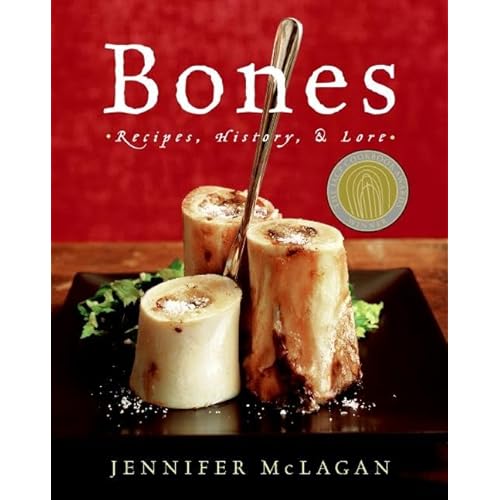Mmm, mmm, bones
My love of bones-in-cooking has been a long, lovingly cultured relationship. Raised from a hearty lineage of Deutschlanders, I fondly remember way back to when I was 6 or so, begging my father for the leftover bone of his round steak. The marrow would dissolve in my little mouth; such a creamy, intense, tongue-rubbing experience. One of those basic, primordial moments of my childhood that seems so natural to me; but dissapointingly out of context with today's mainstream culture.
 Which brings me to my point. I just began reading Jennifer McLagen's Bones,
Which brings me to my point. I just began reading Jennifer McLagen's Bones,
and I got all the way to the top of page 3; where the first paragraph stopped me in my tracks, like some gastronomic mission statement:
Restoring bones to their deserved place in our kitchens will not be easy. First, we must fight against the current fascination with fast and quick, boneless food. Then we need to familiarize ourselves with the whole animal, its essential structure. When we understand where the bones are, we will be able to cook the meat attached to them. And, in a world where resources are increasingly limited, we must learn to value the entire animal. A cow isn't just tenderloin steaks, and there is more to a chicken than boneless breasts. We pay for the bones that are, or were, part of each piece of meat, poultry or fish we, whether we use them or not, so why not benefit from them? Finally, we must seek out knowledgeable, caring suppliers and support them, badger them , and implore them. The more we ask for different cuts, the more they will become available again.
 Which brings me to my point. I just began reading Jennifer McLagen's Bones,
Which brings me to my point. I just began reading Jennifer McLagen's Bones,and I got all the way to the top of page 3; where the first paragraph stopped me in my tracks, like some gastronomic mission statement:
Restoring bones to their deserved place in our kitchens will not be easy. First, we must fight against the current fascination with fast and quick, boneless food. Then we need to familiarize ourselves with the whole animal, its essential structure. When we understand where the bones are, we will be able to cook the meat attached to them. And, in a world where resources are increasingly limited, we must learn to value the entire animal. A cow isn't just tenderloin steaks, and there is more to a chicken than boneless breasts. We pay for the bones that are, or were, part of each piece of meat, poultry or fish we, whether we use them or not, so why not benefit from them? Finally, we must seek out knowledgeable, caring suppliers and support them, badger them , and implore them. The more we ask for different cuts, the more they will become available again.


2 Comments:
Is a "tube steak" boneless???
It can be boneless if your trombone is rusty...
Post a Comment
<< Home